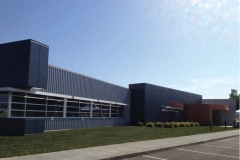Hello, I’m Rashad.
Developer of datacentercatalog.com
I’m currently open to new opportunities—remote or onsite—in the Data Center industry.
With hands-on experience in data center operations, management, and development, I’m ready to help your team succeed.
If you’re looking for someone with real-world expertise, let’s connect!
LinkedIn
How to Strengthen Your Cloud Workload Security
How to Strengthen Your Cloud Workload Security
Whether you’re running virtual machines (VMs), containers, serverless functions, or managed databases, every organization using the cloud has a responsibility to secure its workload.
Cloud workload security focuses on protecting the applications and data that power your business – and ensuring they’re resilient against emerging threats. In this article, we’ll break down what cloud workload security means, what types of workloads you need to consider, and best practices to improve your security posture across your environment.
What Is Cloud Workload Security?
Cloud workload security refers to the practices, tools, and controls used to protect applications and data in cloud environments.
These workloads can include:
- VMs
- Containers
- Serverless functions
- Databases
- Storage objects
- Machine learning models
- APIs
Each of these components plays a critical role in cloud architecture. They also come with unique security considerations.
Components of Cloud Workload Security
Measures that may be taken as part of cloud workload security can include identity and access management (IAM), data protection, threat detection, and monitoring.
Identity and Access Management
IAM is concerned with who has access to cloud resources and what they are allowed to with that access. Only authorized users should be able to access cloud resources, and within that, certain job functions may require different levels of access than others. A strong IAM approach includes authentication, authorization, and role-based access control. It also applies to the principle of least privilege.
Data Protection
Data protection is central to cloud workload security and can involve any measures necessary to keep data safe, including encryption, masking, and tokenizing. These approaches secure data at rest and in transit and can make it possible to analyze customer information while masking sensitive data.
When businesses lose data, there can be serious negative impacts to their revenue, worker confidence, client relationships, and more. Data loss prevention (DLP) tools and policies should be enacted to mitigate data loss, which may include a data loss and recovery plan. Data that is regularly backed up and easy to access can maintain business continuity if data is corrupted or otherwise lost.
Threat Detection and Response
Cybercriminals can exploit zero-day vulnerabilities, weaknesses in internal cybersecurity knowledge, social engineering messages, or stolen credentials to infiltrate. Two of the most common and most expensive attack vectors, according to IBM, include stolen or compromised credentials (16%) and phishing (15%). Ransomware also presents a significant risk after these initial attack vectors have taken hold, locking users out of accounts and demanding payment for encrypted or otherwise inaccessible data. Integrate SIEM/SOAR (Security Information and Event Management / Security Orchestration, Automation, and Response) to enable automated threat response and remediation.
Workload Visibility and Inventory
You can’t secure what you can’t see. Continuous discovery and inventory of workloads across all cloud environments is essential. This includes VMs, containers, serverless functions, APIs, and any associated data services. To improve visibility, leverage asset management, implement cloud-native integrations (AWS Config, Azure Resource Graph, etc.), and add tagging/classification schemes.
Cloud Security Posture Management
Misconfigurations are a top cause of cloud breaches. Security posture management helps you enforce configuration standards and detect drift from known-good states – the secure, functional, and approved state of a system. Cloud Security Posture Management (CSPM) can ensure assets are correctly secured and reinforce baseline policies that align with the Center for Internet Security (CIS) benchmarks. You can also use the tool to monitor for misconfigurations and drift, two major contributors to cloud breaches.
Vulnerability and Patch Management
Keep workloads secure by identifying and patching known vulnerabilities — including in base images, libraries, and dependencies. Businesses should conduct regular vulnerability scans, complete OS and package-level patching, and perform image scanning for containers. The frequency will depend on the sensitivity of your data, the nature of your business, and the risks common for your particular systems.
Network Security and Microsegmentation
Restrict traffic flow to and from workloads to minimize exposure and lateral movement. This can include implementing virtual firewalls and security groups, as well as taking a zero-trust approach to network access (ZTNA). Organizations can also have microsegmentation at the level of the VM or container to limit risks associated with widespread exposure. Network security can also be improved by encrypting traffic via Transport Layer Security (TLS) and Virtual Private Networks (VPNs).
Compliance and Auditability
To enhance compliance and auditability for your business, it’s important to maintain visibility and control. Logging and monitoring tools, such as CloudTrail and Azure Monitor, can generate comprehensive audit trails of access and changes. Automated compliance assessments and effective reporting and alerting mechanisms can support your organization in meeting industry regulations and internal policies.
Understanding the Common Categories of Cloud Workloads
Before you can strengthen your cloud workload security, you need to understand what types of workloads you’re protecting. While cloud service models like IaaS, PaaS, and SaaS define how cloud services are delivered, workload types describe what is running in your cloud environment.
While there are other workloads your business may use, including web apps, big data, AI/ML workloads, backup/disaster recovery (DR) or archival workloads, and virtual desktop infrastructure (VDI) workloads, these are the three most common categories you’re likely to encounter.
1. VMs and Lift-and-Shift Applications
VMs and lift-and-shift applications are workloads that have been moved from on-premises. They often involve running full operational systems on cloud infrastructure, making them similar to on-premises VMs, but they’ve been hosted on IaaS platforms like AWS EC2 or Azure VMs. Security considerations businesses want to keep in mind with these workloads include patch management, OS hardening, endpoint protection, and network segmentation.
2. Containerized Applications and Microservices
These workloads are built using containers (i.e. Docker) and are orchestrated with platforms like Kubernetes. They’re often part of modern, cloud-native architectures and enable faster deployment and scalability. Organizations must consider container image security, runtime protections, identity and access controls, and abide by Kubernetes security best practices.
3. Serverless and Managed Services Workloads
These workloads include function-as-a-service (i.e. AWS Lambda, Azure Functions) and other PaaS services such as managed databases, message queues, or API gateways. While these workloads abstract away the infrastructure and offer more speed and agility to businesses, they also require a different approach to securing your code and data. Businesses should implement the least privilege principle to IAM, secure their APIs, ensure input validation, set up logging and monitoring, and establish secure development practices.
Cloud Workload Security Best Practices
Strong security in cloud workloads requires a proactive and thorough approach to counter all potential threat vectors at all possible stages of infiltration. By applying strong access controls, encrypting data, performing regular security audits, and leveraging automation, organizations can greatly reduce the risk of incoming threats to their cloud workloads.
1. Automate CSPM
Manual checks don’t scale in the cloud. Use tools like CSPM and IaC scanning to continuously evaluate and remediate misconfigurations across workloads. This way, you can automatically detect drift from your security baselines. You can also use the tools to enforce policies as code in continuous integration / continuous development (CI/CD) pipelines. Common misconfigurations can also be auto-remediated, such as open S3 buckets or over-permissioned roles.
2. Use AI-Powered Threat Detection
Modern attacks are fast and stealthy – your defense needs to be smarter and faster to respond appropriately. Use AI/ML-based tools to detect anomalies, predict risks, and surface threats across cloud workloads. AI/ML tools can offer behavioral analytics for VMs, containers, and functions, quickly noting anomalies. You can also incorporate AI-driven threat intelligence and prioritization, focusing on the most salient threats and addressing them first. Intelligent correlation can also alert you to the most important things as the system is trained on your data, reducing risks associated with alert fatigue.
3. Implement Zero Trust Principles Across Workloads
Trust nothing, verify everything. The zero-trust principle means that you apply the least privileged access to users possible and maintain strict identity controls across users, services, and APIs. Instead of hardcoded credentials, your organization can use short-lived workload identity credentials as needed. Network segmentation and deny-by-default policies will limit the access users have to your systems. You can also continuously validate users and devices instead of inherently trusting previous authentication.
4. Shift Left and Integrate Security into DevOps
Bake security into the development lifecycle — don’t bolt it on later. Use automation to catch and fix issues before workloads are deployed. In CI/CD pipelines, this can look like containers and code scanning.
To improve security and compliance, DevOps teams can complete IaC validation, verifying that the security and correctness of the code is set before it is deployed. Enhanced collaboration as a DevSecOps team can shorten feedback loops between functions.
Key Challenges in Cloud Workload Security
Being proactive is important in achieving greater cloud workload security, but it’s also essential to be mindful of the ongoing challenges businesses face that may pose unexpected obstacles.
- Evolving Threat Landscape and Advanced Attacks: As previously mentioned, stolen or compromised credentials create the biggest initial attack vector for data breaches. This is followed by phishing and cloud misconfiguration. When attackers use stolen or compromised credentials, it costs businesses $4.81 million on average. Cloud-native workloads face increasingly sophisticated threats, and legacy security tools often lack the context or agility to detect and respond effectively. The best practices listed above can prevent issues from misconfigurations, limited visibility, and most vulnerabilities. Training employees to spot phishing and social engineering messages can also greatly decrease your risk of falling victim to data breaches.
- Misconfigurations and Inconsistent Security Policies: From overly permissive IAM roles to exposed storage buckets, small mistakes can create big vulnerabilities, especially when configuration isn’t automated or standardized.
- Lack of Visibility and Inventory Across Cloud Environments: Most businesses don’t just use one cloud environment. Instead, they adopt hybrid or multicloud environments. According to Flexera’s survey sent to 753 cloud decision-makers, 89% of organizations employ a multicloud infrastructure, with 73% of them choosing hybrid cloud, while 14% use multiple public and 2% use multiple private clouds. In dynamic, multi-cloud environments, workloads are constantly spinning up and down. These processes are often automated and decentralized. This makes it difficult to maintain an accurate, real-time inventory of what’s running, where, and who has access.
Managing the Complexities of Cloud Security
If it wasn’t already clear, managing cloud security can be a complex undertaking. Automating your security posture, leveraging AI/ML tools, implementing zero trust approaches, and prioritizing security with a DevSecOps team can help organizations stay one step ahead of security threats.
CSPM tools can assess compliance and vulnerabilities, Cloud Workload Protection Platforms (CWPP) can provide workload protection, and Security Orchestration, Automation, and Response (SOAR) can streamline your incident response processes. Combining technologies with the previously detailed best practices can make the complex feel more straightforward.
Choose a Cloud Partner You Can Trust
Finally, consider partnering with a cloud provider to augment in-house capabilities with specialized expertise and 24/7 monitoring. A trusted partner like TierPoint can significantly enhance your security posture, freeing your internal team to focus on strategic initiatives and drive greater innovation. Learn more about our security consulting services and schedule a consultation today.

More >> How to Strengthen Your Cloud Workload Security


